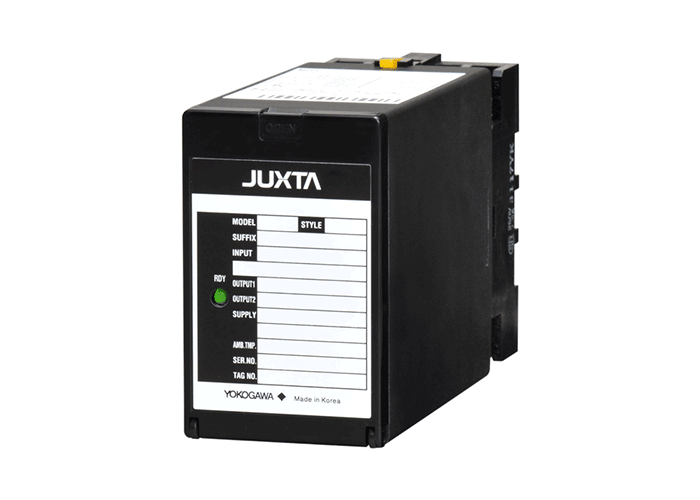M Series unified signal converters are plug-in type signal conditioners for common instrumentation signals. They have an I/O signal range of 4 to 20 mA DC or 1 to 5 V DC.
Details
The M Series bring Yokogawa performance and reliability to the popular plug-in style. Using industry standard pin configurations, anyone can upgrade to JUXTA performance by just plugging one in. The M Series signal conditioners for unified signals are applicable to the unified input/output signal applications for cost saving design.
- For 4 to 20 mA DC or 1 to 5 V DC unified input/output signal applications.
- Designed for 2000 VAC of high withstand voltage.
- Two isolated outputs (MA7D and MH7D).
- Plug-in type construction Easy for instrumentation planning, field wiring and maintenance because of its flexible insertion/extraction and ability to be pre-wired.
| Construction | Plug-in type (Main unit with Socket) |
|---|---|
| Mounting Method: | Wall mounting or DIN-rail mounting |
| Connection Method: | M3.5 screw terminal |
| External Dimensions: | Model MH7, MA7, MCT7, MPT7: 85×50×123 mm (H×W×D) |
| Model MH7D, MA7D: 85×50×132 mm (H×W×D) | |
| Power Requirements: | 24 V DC±10% , 85 to 132 V AC / 85 to 150 V DC or 170 to 264 V AC |
Signal Conditioners
| Model | Product Name | Input Type | Output Type | Descriptions |
|---|---|---|---|---|
| MA7 | Distributor (Unified Signal Type) | 4 to 20 mA DC, from 2-wire type transmitter | 1 to 5 V DC or 4 to 20 mA DC | |
| MA7D | Distributor (2-output, Unified Signal Type) | Isolated 2 outputs | ||
| MCT7 | CT Converter(RMS) | 0 to 1 A or 0 to 5 A AC | 4 to 20 mA DC or 1 to 5 V DC | |
| MH7 | Isolator (Unified Signal Type) | 1 to 5 V DC or 4 to 20 mA DC | 1 to 5 V DC or 4 to 20 mA DC | |
| MH7D | Dual Outputs Isolator (Unified Signal, 2-output Type) | Isolated 2 outputs | ||
| MPT7 | PT Converter(RMS) | 0 to 110 V AC, 0 to 150 V AC or 0 to 300 VAC | 4 to 20 mA DC or 1 to 5 V DC |
Zdroje
Downloads
Instrukční manuály
- Model MA7 Distributor (Unified Signal Type) (500 KB)
- Model MPT7 PT Converter (RMS) (488 KB)
- Model MCT7 CT Converter (RMS) (490 KB)
- Model MA7D Distributor (Dual-output and Unified Signal Type) (476 KB)
- Model MH7 Isolator (Unified Signal Type) (505 KB)
- Model MH7D Isolator (Dual-output and Unified Signal Type) (477 KB)
Všeobecné specifikace
- Model VJB1 CT Converter (RMS) (253 KB)
- Model MPT7 PT Converter (RMS) (584 KB)
- Model MA7 Distributor (Unified Signal Type) (614 KB)
- Model MA7D Distributor (Dual-output and Unified Signal Type) (586 KB)
- Model MH7 Isolator (Unified Signal Type) (618 KB)
- Model MH7D Isolator (Dual-output and Unified Signal Type) (570 KB)
Technické informace
Výkresy
- Model MPT7 PT Converter (RMS) (227 KB)
- Model MCT7 CT Converter (RMS) (229 KB)
Potřebujete víc informací o lidech, technologii a řešeních?
Kontaktuje nás